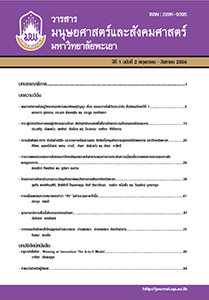การเปลี่ยนแปลงความหมายของคำว่า “หัว” ในคำประสมภาษาไทลื้อ
Keywords:
ความหมาย, หัว, คำประสม, ภาษาไทลื้อ, Meaning, Head, Compound Words, Tai Lue LanguageAbstract
การวิจัยเรื่อง “การเปลี่ยนแปลงความหมายของคำว่า ‘หัว’ ในคำประสมภาษาไทลื้อ” มีวัตถุประสงค์เพื่อศึกษาการเปลี่ยนแปลงความหมายของคำว่า “หัว” ในคำประสมภาษาไทลื้อ โดยศึกษาตามแนวคิดกระบวนการอุปลักษณ์ (metaphor) และแนวคิดกระบวนการนามนัย (metonymy) ของจอร์จ เลคอฟ และมาร์ค จอห์นสัน (George Lakoff and Mark Johnson) [1] แนวคิดเรื่องแบบการเปลี่ยนแปลงความหมาย ของลาดิสลัฟ ซกุสตา (Ladislav Zgusta) [2] ทฤษฎีต้นแบบ (prototype theory) ของทาล์มี กิวอน (Talmy Givón) [3] และแนวคิดเครือข่ายความหมาย (semantic network) ของแอนเดรีย ไทเลอร์ และวิเวียน เอแวนส์ (Andrea Tyler and Vyvyan Evans) [4]
การวิจัยครั้งนี้ได้เก็บรวบรวมข้อมูลจากเอกสารอักษรไทลื้อ ซึ่งเป็นเอกสารจากสิบสองพันนา มณฑลยูนนาน ประเทศจีน แบ่งออกเป็น 9 ประเภท ได้แก่ เอกสารประวัติศาสตร์ จารีตประเพณี วรรณกรรม นิทาน ตำรา แบบเรียน สุภาษิต บทเพลง และหนังสือพิมพ์
ผลการวิจัยพบว่า คำว่า “หัว” ในคำประสมภาษาไทลื้อจำนวน 106 คำ มีความหมายเปลี่ยนแปลงจากความหมายเบื้องต้นทั้งหมด 30 ความหมาย แบ่งออกเป็น 4 กลุ่ม ได้แก่ 1) ความหมายกลุ่ม “อวัยวะ” 2) ความหมายกลุ่ม “ความเป็นหน่วย” 3) ความหมายกลุ่ม “พื้นที่หรือเวลา” และ 4) ความหมายกลุ่ม “คุณสมบัติ”
A Study of Semantic Changes of Head in Compound Words of Tai Lue Language
Sarawut Lordee
Department of Thai, Faculty of Humanities, Chiang Mai University
The present study aims to examine the semantic changes of the word, “head” (or hua in Thai) in compound words of Tai Lue language. The theoretical framework is based on metaphor and metonymy concepts (George Lakoff and Mark Johnson), meaning changes concepts (Ladislav Zgusta), prototype theory (Talmy Givón) and semantic network (Andrea Tyler and Vyvyan Evans).
The study collects data from Tai Lue alphabet found in Xishuangbanna document, Yunnan District, China. The document is divided into nine types namely historical document, custom and culture, literature, tale, text, book, proverb, song and newspaper.
The results reveal that there are 106 compound words with “head” and there are 30 meaning that have the semantic changes from the primary meaning. The meanings can be categorized into four groups namely 1) ‘organ’ meaning; 2) ‘being unit’ meaning; 3) ‘area or time’ meaning and 4) ‘qualification’ meaning.
Downloads
How to Cite
Issue
Section
License
ผู้นิพนธ์ต้องรับผิดชอบข้อความในบทนิพนธ์ของตน มหาวิทยาลัยพะเยาไม่จำเป็นต้องเห็นด้วยกับบทความที่ตีพิมพ์เสมอไป ผู้สนใจสามารถคัดลอก และนำไปใช้ได้ แต่จะต้องขออนุมัติเจ้าของ และได้รับการอนุมัติเป็นลายลักษณ์อักษรก่อน พร้อมกับมีการอ้างอิงและกล่าวคำขอบคุณให้ถูกต้องด้วย
The authors are themselves responsible for their contents. Signed articles may not always reflect the opinion of University of Phayao. The articles can be reproduced and reprinted, provided that permission is given by the authors and acknowledgement must be given.








